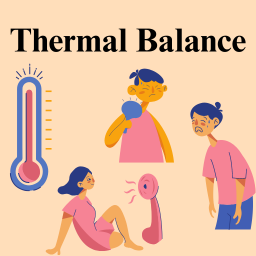The Temperature Balance and Regulation In Health Care. In healthcare, temperature balance and regulation are crucial for patient well-being and treatment outcomes.
The body’s natural thermoregulation system, primarily controlled by the hypothalamus, maintains core body temperature around 37°C (98.6°F) by balancing heat generation and heat loss. Healthcare professionals monitor and manage temperature fluctuations to ensure patients are in a safe and healthy temperature range.
What is Thermal Balance or Temperature Balance and Regulation In Health
Thermal balance refers to a state where the body’s heat loss is equivalent to its heat gain, resulting in a thermoneutral state optimal for cellular function. Typically, this balance maintains human internal temperatures around 37°C±0.05 and skin temperatures at about 33.5°C±0.05. These temperatures are subject to fluctuations influenced by homeostatic and circadian rhythms, reflecting the body’s ability to adapt to various environmental and physiological changes.
Thermal Regulation
The core temperature of the body follows a circadian rhythm, controlled by a stable endogenous clock, making it a reliable indicator of this biological process. The hypothalamus plays a crucial role in regulating internal temperature, ensuring stability despite environmental changes or inherent heat production through metabolic and physical activity. This regulation involves intricate control systems that trigger compensatory cooling or warming mechanisms if temperatures deviate from the set point range.
For example, an increase in temperature prompts processes like vasodilation and sweating to dissipate heat, while a decrease triggers vasoconstriction, shivering, and heightened metabolic activity to conserve or generate heat. These physiological adjustments influence heat transfer through mechanisms such as conduction, convection, radiation, and evaporation.
Nursing Care and Thermal Assessment
Nursing professionals have long recognized the importance of monitoring thermal balance as a critical indicator of health. Body temperature assessments can signal various conditions, from metabolic and neurological disorders to infections. Factors like circadian rhythms, menstrual cycles, and the specific needs of pregnant mothers or individuals with compromised health underscore the importance of precise temperature management in clinical settings.
For instance, elevated temperatures in expectant mothers can pose risks to the fetus, potentially leading to neurological damage, making careful monitoring essential. Similarly, distinguishing between fever and hyperthermia in acutely ill or injured patients is crucial, as each condition requires different management strategies.
Thermal Regulation Patterns
Historically, nurses have used fever patterns to monitor the progression of infections, using physical methods like ice packs, sponge baths, or fans to manage high temperatures. Advances in technology, such as conductive cooling blankets introduced in the 1970s, have enhanced the ability to control severe hyperthermia, though they may induce shivering, which has led to further studies and interventions by nurses to mitigate this response.
The advent of sophisticated thermometry tools has deepened the understanding of temperature variations across different body regions, promoting more accurate and reliable assessments. Studies have emphasized the importance of understanding the gradients between core and peripheral temperatures, as these can trigger significant thermoregulatory responses.
Temperature Measuring Issues in Nursing
The evolution of temperature measurement technologies continues to be a significant focus in nursing research. Studies by researchers like Erickson have explored the reliability of various measurement sites across different patient demographics, confirming the efficacy of methods like oral temperature measurements in afebrile patients and examining the impact of measurement techniques on clinical outcomes.
This ongoing research is critical, not only for developing better temperature measurement tools but also for enhancing the overall understanding of thermal regulation in clinical settings. The insights gained from these studies help refine nursing practices and interventions aimed at maintaining thermal balance, particularly among vulnerable populations such as infants, the elderly, or those recovering from surgery.
Newer Researches for Clinical Aspects of Thermal Regulation
Recent research in thermal regulation has expanded into areas like the effects of exercise on thermoregulatory responses and the circadian influences on thermoregulation in conditions like obesity. As nursing professionals venture into genetics, immunology, and molecular biology, their contributions are increasingly vital in exploring the origins and mechanisms of thermoregulatory responses.
Emerging areas of concern include the thermal regulation challenges faced by the frail elderly population, who are particularly susceptible to temperature extremes due to decreased metabolic rates and insulative capacities. Nursing research is also beginning to address thermoregulatory failures in homebound patients and the interplay between body temperature and the efficacy of various therapeutic interventions.
Conclusion
The regulation of body temperature and the maintenance of thermal arbalance e critical components of effective health care, influencing a wide range of clinical outcomes. Advances in nursing practice and research continue to enhance our understanding and management of thermal regulation, ensuring better patient care across all demographics and clinical settings. This comprehensive approach not only addresses current health care challenges but also adapts to emerging trends and technologies in the field.
Temperature Balance and Regulation In Health Care
Temperature Balance and Regulation In Health Care
Temperature Balance and Regulation In Health Care
Temperature Balance and Regulation In Health Care
Temperature Balance and Regulation In Health Care
Read More:
https://nurseseducator.com/didactic-and-dialectic-teaching-rationale-for-team-based-learning/
https://nurseseducator.com/high-fidelity-simulation-use-in-nursing-education/
First NCLEX Exam Center In Pakistan From Lahore (Mall of Lahore) to the Global Nursing
Categories of Journals: W, X, Y and Z Category Journal In Nursing Education
AI in Healthcare Content Creation: A Double-Edged Sword and Scary
Social Links:
https://www.facebook.com/nurseseducator/
https://www.instagram.com/nurseseducator/
